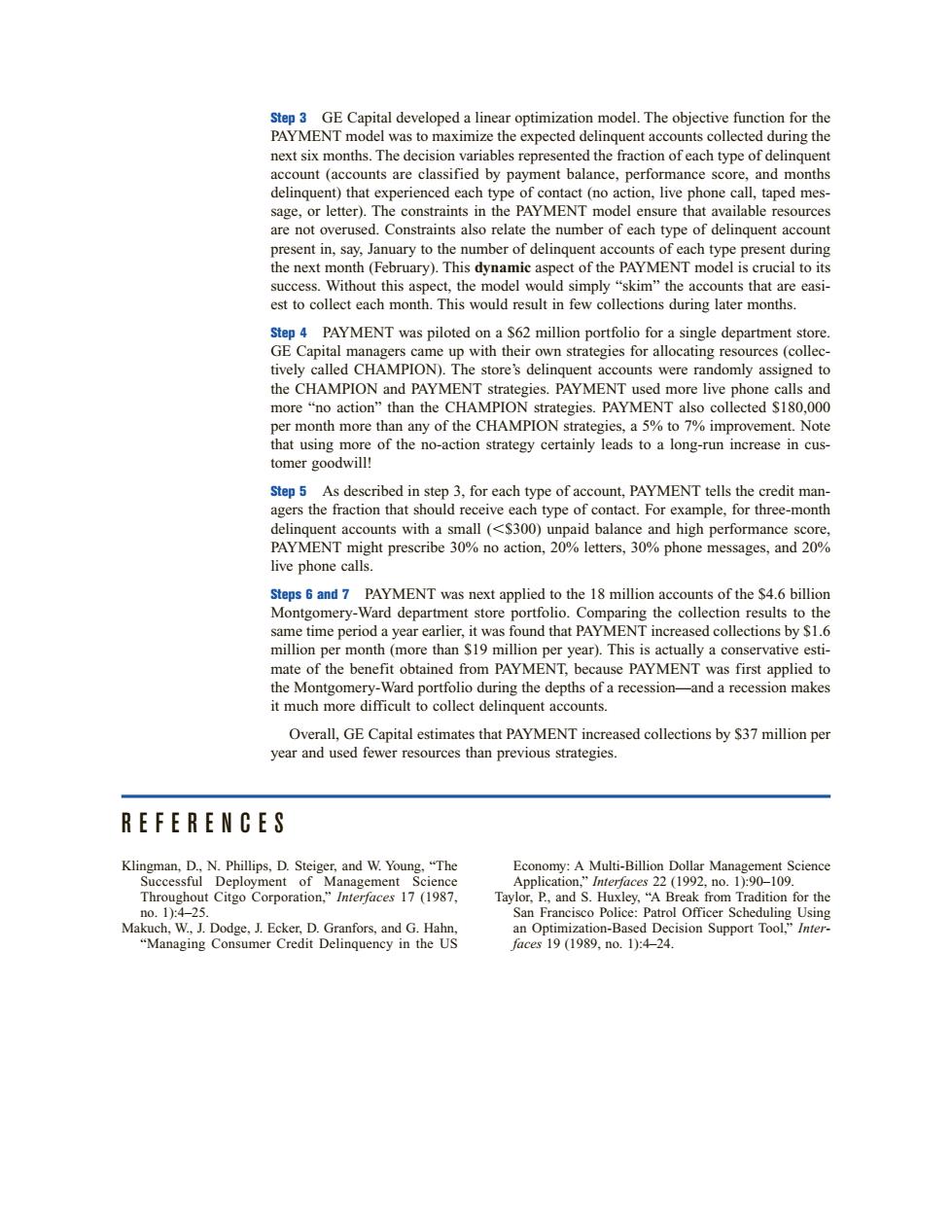正在加载图片...

Step 3 GE Capital developed a linear optimization model.The objective function for the PAYMENT model was to maximize the expected delinquent accounts collected during the next six months.The decision variables represented the fraction of each type of delinquent account (accounts are classified by payment balance,performance score,and months delinquent)that experienced each type of contact(no action,live phone call,taped mes- sage,or letter).The constraints in the PAYMENT model ensure that available resources are not overused.Constraints also relate the number of each type of delinquent account present in,say,January to the number of delinquent accounts of each type present during the next month (February).This dynamic aspect of the PAYMENT model is crucial to its success.Without this aspect,the model would simply"skim"the accounts that are easi- est to collect each month.This would result in few collections during later months Step 4 PAYMENT was piloted on a $62 million portfolio for a single department store. GE Capital managers came up with their own strategies for allocating resources(collec- tively called CHAMPION).The store's delinquent accounts were randomly assigned to the CHAMPION and PAYMENT strategies.PAYMENT used more live phone calls and more "no action"than the CHAMPION strategies.PAYMENT also collected $180,000 per month more than any of the CHAMPION strategies,a 5%to 7%improvement.Note that using more of the no-action strategy certainly leads to a long-run increase in cus- tomer goodwill! Step 5 As described in step 3,for each type of account,PAYMENT tells the credit man- agers the fraction that should receive each type of contact.For example,for three-month delinquent accounts with a small(<$300)unpaid balance and high performance score, PAYMENT might prescribe 30%no action,20%letters,30%phone messages,and 20% live phone calls. Steps 6 and 7 PAYMENT was next applied to the 18 million accounts of the $4.6 billion Montgomery-Ward department store portfolio.Comparing the collection results to the same time period a year earlier,it was found that PAYMENT increased collections by $1.6 million per month(more than $19 million per year).This is actually a conservative esti- mate of the benefit obtained from PAYMENT,because PAYMENT was first applied to the Montgomery-Ward portfolio during the depths of a recession-and a recession makes it much more difficult to collect delinquent accounts. Overall,GE Capital estimates that PAYMENT increased collections by $37 million per year and used fewer resources than previous strategies. REFERENCES Klingman,D.,N.Phillips,D.Steiger,and W.Young."The Economy:A Multi-Billion Dollar Management Science Successful Deployment of Management Science Application,"Interfaces 22(1992,no.1):90-109. Throughout Citgo Corporation,"Interfaces 17 (1987, Taylor,P,and S.Huxley,"A Break from Tradition for the no.1):4-25. San Francisco Police:Patrol Officer Scheduling Using Makuch,W.,J.Dodge,J.Ecker,D.Granfors,and G.Hahn, an Optimization-Based Decision Support Tool,"Inter- "Managing Consumer Credit Delinquency in the US faces19(1989,no.1):4-24.Step 3 GE Capital developed a linear optimization model. The objective function for the PAYMENT model was to maximize the expected delinquent accounts collected during the next six months. The decision variables represented the fraction of each type of delinquent account (accounts are classified by payment balance, performance score, and months delinquent) that experienced each type of contact (no action, live phone call, taped message, or letter). The constraints in the PAYMENT model ensure that available resources are not overused. Constraints also relate the number of each type of delinquent account present in, say, January to the number of delinquent accounts of each type present during the next month (February). This dynamic aspect of the PAYMENT model is crucial to its success. Without this aspect, the model would simply “skim” the accounts that are easiest to collect each month. This would result in few collections during later months. Step 4 PAYMENT was piloted on a $62 million portfolio for a single department store. GE Capital managers came up with their own strategies for allocating resources (collectively called CHAMPION). The store’s delinquent accounts were randomly assigned to the CHAMPION and PAYMENT strategies. PAYMENT used more live phone calls and more “no action” than the CHAMPION strategies. PAYMENT also collected $180,000 per month more than any of the CHAMPION strategies, a 5% to 7% improvement. Note that using more of the no-action strategy certainly leads to a long-run increase in customer goodwill! Step 5 As described in step 3, for each type of account, PAYMENT tells the credit managers the fraction that should receive each type of contact. For example, for three-month delinquent accounts with a small ($300) unpaid balance and high performance score, PAYMENT might prescribe 30% no action, 20% letters, 30% phone messages, and 20% live phone calls. Steps 6 and 7 PAYMENT was next applied to the 18 million accounts of the $4.6 billion Montgomery-Ward department store portfolio. Comparing the collection results to the same time period a year earlier, it was found that PAYMENT increased collections by $1.6 million per month (more than $19 million per year). This is actually a conservative estimate of the benefit obtained from PAYMENT, because PAYMENT was first applied to the Montgomery-Ward portfolio during the depths of a recession—and a recession makes it much more difficult to collect delinquent accounts. Overall, GE Capital estimates that PAYMENT increased collections by $37 million per year and used fewer resources than previous strategies. REFERENCES 10 CHAPTER 1 An Introduction to Model Building Klingman, D., N. Phillips, D. Steiger, and W. Young, “The Successful Deployment of Management Science Throughout Citgo Corporation,” Interfaces 17 (1987, no. 1):4–25. Makuch, W., J. Dodge, J. Ecker, D. Granfors, and G. Hahn, “Managing Consumer Credit Delinquency in the US Economy: A Multi-Billion Dollar Management Science Application,” Interfaces 22 (1992, no. 1):90–109. Taylor, P., and S. Huxley, “A Break from Tradition for the San Francisco Police: Patrol Officer Scheduling Using an Optimization-Based Decision Support Tool,” Interfaces 19 (1989, no. 1):4–24